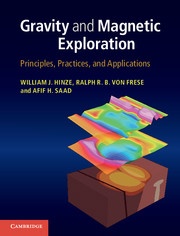Book contents
- Frontmatter
- Dedication
- Contents
- Preface
- Acknowledgements
- 1 Introduction
- Part I Gravity exploration
- Part II Magnetic exploration
- 8 The magnetic method
- 9 Magnetic potential theory
- 10 Magnetization of Earth materials
- 11 Magnetic data acquisition
- 12 Magnetic data processing
- 13 Magnetic anomaly interpretation
- Part III Applications
- Appendix A Data systems processing
- References
- Index
11 - Magnetic data acquisition
from Part II - Magnetic exploration
Published online by Cambridge University Press: 05 May 2013
- Frontmatter
- Dedication
- Contents
- Preface
- Acknowledgements
- 1 Introduction
- Part I Gravity exploration
- Part II Magnetic exploration
- 8 The magnetic method
- 9 Magnetic potential theory
- 10 Magnetization of Earth materials
- 11 Magnetic data acquisition
- 12 Magnetic data processing
- 13 Magnetic anomaly interpretation
- Part III Applications
- Appendix A Data systems processing
- References
- Index
Summary
Overview
The acquisition of magnetic data is relatively simple, rapid, and less complex than are the observations of data of most geophysical methods. Significant improvements continue to be made in magnetic instrumentation which facilitate accurate observation of the geomagnetic field on the Earth's surface as well as on a variety of airborne platforms, and from satellites of the Earth, Moon, and planets of the solar system. Most observations are made of the scalar, total intensity of the field, with alkali-vapor (resonance) magnetometers which readily achieve a sensitivity of better than a nanotesla with rates of several observations per second from a moving platform. These measurements are supplemented for special purposes by measurements of gradients, vectors, and tensors. Vector and tensor measurements are made with flux-gate magnetometers and increasingly with the highly sensitive superconducting quantum interference device magnetometers.
Surface or near-surface surveys are conducted on grids or parallel lines to map with high resolution the near-surface, local magnetic anomalies associated with a variety of archaeological, engineering, and environmental problems, but most magnetic surveys are conducted from a wide variety of airborne platforms. Although helicopter surveys may use outboard sensors placed in an aerodynamically stable housing at the end of a cable towed by the helicopter to place the sensor close to the surface to achieve the highest possible resolution, most airborne surveys use inboard sensors which require that extraneous magnetic effects of the aircraft are compensated by passive and active systems.
- Type
- Chapter
- Information
- Gravity and Magnetic ExplorationPrinciples, Practices, and Applications, pp. 276 - 299Publisher: Cambridge University PressPrint publication year: 2013
- 1
- Cited by



